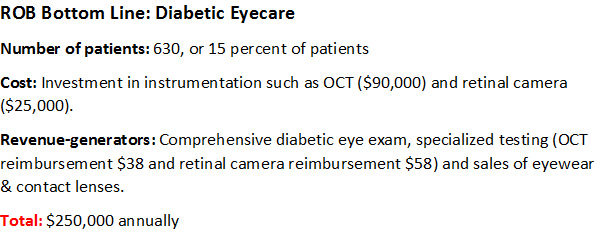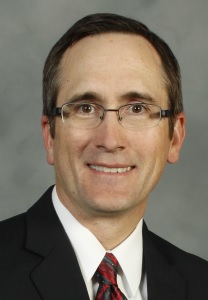By Christopher J. Babin, OD

June 13, 2018
Diabetes is a significant healthcare challenge. According to the Centers for Disease Control, 30.4 million Americans have diabetes, and one-in-four of them don’t know they have it. Many of those people will make their way into your exam room. My practice has carefully thought about our protocol for treating diabetic patients, and has found their care to be a practice-builder.
We have approximately 630 diabetic patients, whom comprise about 15 percent of my patient base. Care of these individuals brings in approximately $150,000 annually. The revenues are generated by the comprehensive diabetic eye exam, special testing such as ocular coherence tomography, retinal photos and visual fields (when glaucoma is suspected). Income also is generated from the sale of eyeglasses and contact lenses. Most of my diabetic patients come in for an annual eye exam unless there is evidence of retinopathy that requires more frequent visits.
It may take several years to achieve this volume of patients and profitability. From a practice-building standpoint, it is important to always communicate findings with the patient’s primary care provider. This is important because it may lead to changing diabetes treatment (if retinopathy is worsening), and also educates the PCP that you (as the primary eyecare provider) are knowledgeable regarding diagnosing and managing diabetic retinopathy. Sending summaries to PCPs will also generate referrals of other patients in need of diabetic eye exams.
Including eyeglasses, and contact lens sales, care of patients with diabetes generates approximately $250,000 annually.
 Be Part of a Team of Health-Care Providers
Be Part of a Team of Health-Care Providers
Providing comprehensive eyecare services for diabetic patients means becoming part of a team of health-care providers. Diabetes is a systemic disease, affecting many different areas of the body, with the eyes being just one of those key areas that is impacted.
I co-manage diabetic patients with general ophthalmologists, retina specialists, family-medicine doctors, endocrinologists, physician assistants, advanced registered nurse practitioners and certified diabetes educators.
Equip Your Office With Needed Instrumentation
There is a variety of advanced instrumentation that can help you monitor the eye health of diabetic patients. Two primary pieces of equipment that help with care of these patients are ocular coherence tomography (OCT) and a visual field analyzer.
I use the OCT to screen the patient if I am suspicious of diabetic macular edema, and use our visual field analyzer, along with an OCT photo of the disc, if the patient is also glaucoma suspect. Retinal photographs are also sometimes taken to document the level of retinopathy, and for future comparison.
Every patient will have a fundus examination, either with Optos imaging and/or dilated fundus examination. If a patient initially opts for the Optos imaging, which shows retinopathy, I like to also dilate the patient’s eyes.
The cost of OCTs range widely with the latest Zeiss Cirrus Angioplex costing approximately $90,000. One can also consider the Optos Monaco, which includes wide-field retinal imaging along with OCT (about $90,000.) Reimbursement for OCT imaging is about $38, and retinal photographs about $58. This obviously requires a lot of testing to make the equipment pay for itself. However, remember these can also be used with a variety of other patients, such as those with macular degeneration and glaucoma.
Educate Patients on the Importance of Regular Eye Examinations
Your well-equipped office, and protocol for care, won’t matter if patients don’t understand the importance of following through with the treatment plan you have prescribed, including making it to all of their appointments with you.
We have a variety of patient education brochures available in our office published by some of our local co-management centers, as well as those from the American Optometric Association. Following my discussion with my patients my technician will hand the patient this educational material, ask them to read through it, and to feel free to contact our office with any questions.
In addition to in-office education, the doctors in our practice will sometimes make presentations in our community to diabetes support groups, senior citizen groups, or other interested organizations.
The educational message I like to get across to my patients is that diabetes is the leading cause of vision loss in the 25-74-year-old population, and that they need to take charge of their diabetes rather than the other way around. With proper management, including medication, diet and exercise, diabetes control is attainable, and with that, we can give our patients the best chance to maintain good vision for a lifetime.
Help Patients Manage their Insurance to Access Treatment
Many of our patients prefer their exam to be billed to their vision insurance, which we gladly comply with, when we can. If we determine these patients need special testing, we review this with the patient, and will bill their medical insurance, including Medicare, for these services.
Keep Your Knowledge Up to Date
There are numerous courses and resources that can help make caring for diabetic patients more comfortable, enjoyable and rewarding. One great resource is the AOA’s Evidence-based Clinical Practice Guideline Eye Care of the Patient with Diabetes Mellitus. There are also several great speakers who lecture on care of the patient with diabetes, who present at national, regional and state optometry meetings.
Educate Your Support Staff
ODs themselves can be a great resource to support staff in providing them with education about caring for diabetic patients. This training should include guidance on how to obtain a complete diabetic medical history, how to check blood pressure and how to capture retinal photographs and OCT images.
Other staff education resources include your state optometric associations, the AOA, alliances like Vision Source and Think About Your Eyes.
 Chris Babin, OD, is a partner with Cascade Eye Center in Yakima, Wa. To contact: drbabin@cascadeeyecenter.net
Chris Babin, OD, is a partner with Cascade Eye Center in Yakima, Wa. To contact: drbabin@cascadeeyecenter.net





















